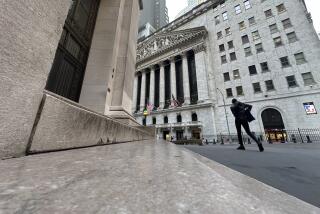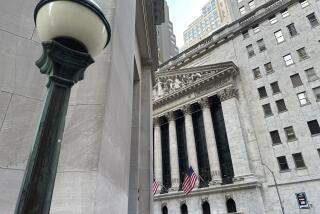Stock Prices Again in Retreat
Stocks resumed their May slide Tuesday, with the Dow index losing more than 180 points amid mounting concerns about the economy.
Investors returned from the holiday weekend in a selling mood as crude oil went back above $72 a barrel and a report showed that consumer confidence ebbed this month.
The news deepened worries that weaker consumer spending and other factors could trigger a serious economic slowdown, analysts said.
“With energy prices at record highs, borrowing costs climbing and the housing market continuing to slow, the headwinds have intensified” for economic growth, said Bob Doll, head of Merrill Lynch Investment Managers in New York.
President Bush’s choice of Wall Street veteran Henry M. Paulson Jr. to take over as Treasury secretary failed to cheer many investors. Paulson is chairman of brokerage giant Goldman Sachs Group.
The Dow Jones industrial average tumbled 184.18 points, or 1.6%, to 11,094.43. The Russell 2,000 index of smaller stocks sank 2.5%, its worst loss in nearly eight months.
The U.S. market’s decline also dragged down overseas shares, a further blow to American investors who have been big buyers of foreign stocks recently.
Still, most major U.S. and foreign market indexes didn’t fall below their lows of last week. That could be a sign that the pullback is ending, some analysts said. Also, trading volume slowed sharply from last week.
Stocks have been slumping worldwide in recent weeks on fears that inflationary pressures could force the Federal Reserve and other central banks to continue tightening credit even if the global economy weakens.
The Dow plummeted 214 points May 17, the biggest one-day drop in three years, after the government reported a surprisingly large increase in consumer prices in April.
On Tuesday, inflation concerns were fanned again as near-term crude oil futures in New York rose 66 cents to $72.03 a barrel, the fifth increase in six trading sessions. That put the price at a two-week high.
Energy traders said oil received a boost after Chinese government data showed that the country’s demand for oil shot up nearly 11% in April from a year earlier. China is the second-largest oil consumer after the U.S.
Record gasoline prices have been pinching many U.S. consumers in recent weeks. Wal-Mart Stores said Monday that sales this month at stores open at least a year were up about 2.3% from a year earlier, at the low end of its previous estimates.
“I think the economy is slowing significantly,” said Tom Higgins, economist at investment firm Payden & Rygel in Los Angeles.
A month ago, many investors were figuring that growth would slow enough to allow the Fed to halt its nearly 2-year-old credit-tightening campaign. Now, rising inflationary pressures could mean that policymakers will have to raise interest rates further, increasing the risk of going too far and triggering a recession, some analysts say.
Higgins, however, said he believed that the economy was headed for a “soft landing,” which he said would mean a slowdown in annualized real growth from the first quarter’s heady pace of 5.3% to a range of 2.5% to 3% in the second half.
“I don’t think the Fed has to go much further” in raising rates, he said.
But in comments Tuesday on CNBC, Michael Moskow, president of the Fed’s Chicago branch, described the economy as “ very strong” and said that the Fed would have to be “very diligent” to keep inflation from getting traction.
His comments rattled the bond market, pushing long-term interest rates higher even as stocks fell. The yield on the 10-year Treasury note rose to 5.08% from 5.05% on Friday. All U.S. markets were closed Monday in observance of Memorial Day.
Gold edged up, gaining $2.90 to $653.90 an ounce in New York. The dollar lost ground against major foreign currencies, in part on uncertainty over what kind of dollar policy the Treasury secretary-designate would recommend, analysts said.
On Wall Street, the stock market fell at the outset and continued to sink the rest of the session. Falling stocks outnumbered winners by more than 3 to 1 on the New York Stock Exchange and on Nasdaq.
Shares of heavy-industry issues led the decline on economic concerns. Caterpillar fell $2.26 to $72.16, Reliance Steel sank $4.89 to $78.56 and Phelps Dodge lost $4.46 to $83.80.
The blue-chip Standard & Poor’s 500 index ended with a loss of 20.32 points, or 1.6%, at 1,259.84. The technology-heavy Nasdaq composite slid 45.63 points, or 2.1%, to 2,164.74.
But the S&P; 500 and the Nasdaq held above their ending levels of May 23, when the market hit its closing lows for the week before rebounding modestly Wednesday through Friday. The Dow ended less than four points below its May 23 close.
Analysts who watch chart patterns for clues to the market’s trend say that breaking below last week’s lows in the major indexes could spark another big downdraft in share prices.
For now, the pullback in U.S. stocks appears to be a classic “correction,” or temporary setback, within a bull market, rather than the end of the bull, Merrill’s Doll said.
Market corrections historically have shaved 10% to 15% from key indexes before share prices stabilized. The Dow is down 4.7% from its six-year high reached May 10. The Nasdaq composite index is down 8.7% from its recent high, and the Russell 2,000 index is off 9.1% from its record high.
Many foreign stock markets have suffered larger losses this month after outpacing U.S. stocks for the last three years. Brazil’s main stock index tumbled 4.5% on Tuesday, pulled down by Wall Street’s woes. The Brazilian market has fallen 13% from its May 9 record high.
German stocks slid 2.3% on Tuesday, Mexican shares fell 3.4% and Japanese stocks were down 0.4%.
Data reported Tuesday showed that Americans continued to be heavy buyers of foreign stock mutual funds in April, continuing the trend of the last two years. Foreign funds had net cash inflows of $18.4 billion last month, compared with an inflow of $8 billion for U.S. stock funds, the Investment Company Institute said.
Many who bought foreign funds in April may be in the red, particularly if their funds own large stakes in emerging markets such as Brazil, Russia and India.
More to Read
Inside the business of entertainment
The Wide Shot brings you news, analysis and insights on everything from streaming wars to production — and what it all means for the future.
You may occasionally receive promotional content from the Los Angeles Times.










